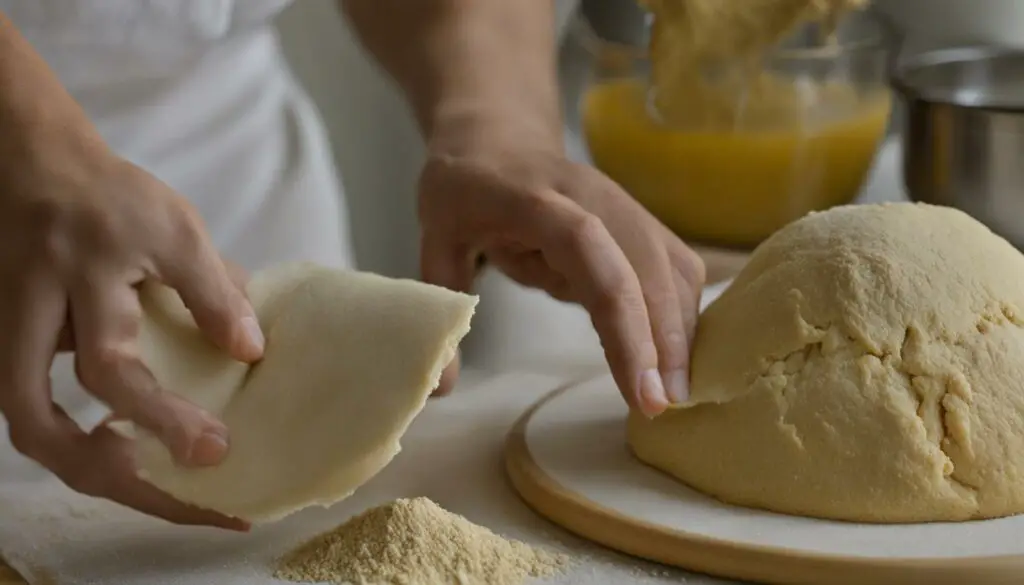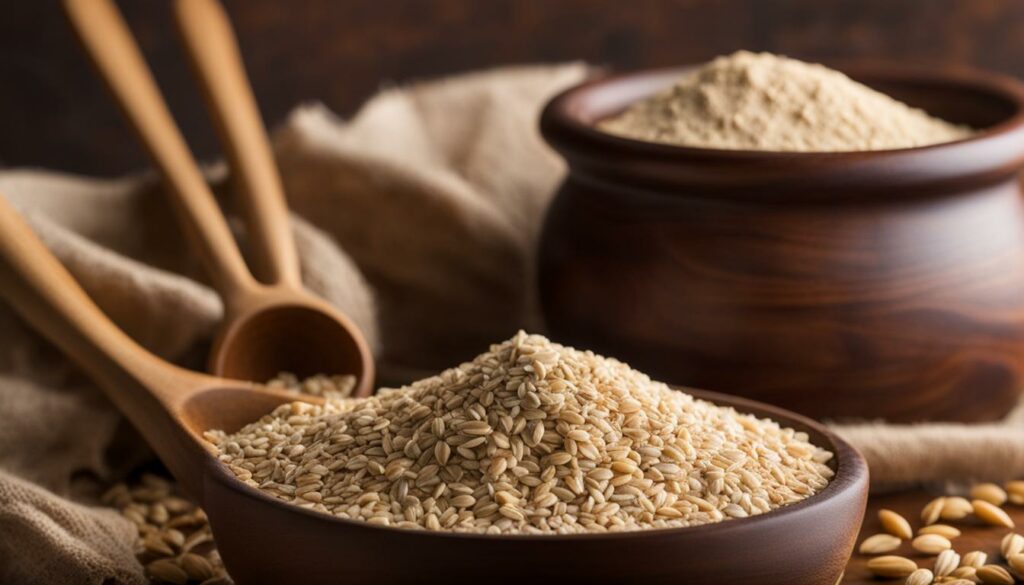If you’re a pizza lover, you know that the crust is just as important as the toppings. And if you’re looking to switch up your pizza game, you might be wondering about substituting semolina flour for pizza. Whether you’re looking for a gluten-free option or just want to experiment with different flours, we’ve got you covered in this ultimate guide to the best semolina flour substitutes for pizza.
Semolina flour is a popular ingredient in pizza crusts, known for its high protein content and ability to create a crispy crust. However, it’s not always easy to find, and some people may have gluten allergies or sensitivities that make semolina flour off-limits. But fear not, because we’ve tried and tested various semolina flour substitutes for you.
In the sections below, we’ll provide an overview of the characteristics of semolina flour and how to substitute it in pizza dough. We’ll also introduce some of the best semolina flour substitutes, such as bread flour, all-purpose flour, whole wheat flour, and gluten-free flour. We’ll explore each flour’s texture, flavor, and how it can affect the baking process. Plus, we’ll include some delicious pizza recipes featuring each substitute.
Key Takeaways
- Semolina flour is a popular pizza crust ingredient known for its crispy texture.
- If you can’t find semolina flour or have a gluten allergy, there are plenty of substitutes available.
- Bread flour is an excellent substitute that can achieve a crispy and chewy crust.
- All-purpose flour, whole wheat flour, gluten-free flour, cornmeal, and rice flour are also great substitutes worth trying.
- Experimentation is key in finding your perfect pizza crust, so don’t be afraid to try different flours and techniques.

Understanding Semolina Flour for Pizza
If you’re a pizza enthusiast, you’ve probably heard of semolina flour as a popular ingredient for creating the perfect pizza crust. Semolina flour is a type of durum wheat flour that is commonly used in Italian cuisine, particularly for pasta and bread. However, its coarse texture and high gluten content make it an ideal choice for pizza dough as well.
When it comes to pizza crust, semolina flour plays a crucial role in producing a crispy and chewy texture. Its coarse texture allows it to absorb more water than regular flour, resulting in a dough that is more elastic and easier to work with. Additionally, its high gluten content means the dough will rise more and have a more open crumb structure, perfect for holding toppings in place.
Using semolina flour in your pizza dough can be a game-changer, but it’s important to note that it can be tricky to work with. Its coarse texture can make the dough tough and difficult to stretch, and it can also be prone to burning quickly in the oven due to its high sugar content. However, with a little practice and some tips and tricks, you can master the art of using semolina flour in your pizza dough.
Techniques for Incorporating Semolina Flour
There are several techniques you can use to incorporate semolina flour into your pizza dough. One method is to combine it with regular flour in a 50/50 ratio. This will give you a dough with the perfect balance of texture and flavor. Alternatively, you can use semolina flour as a dusting agent on your work surface to prevent the dough from sticking. This will also add some extra crunch to the crust.
Another option is to use semolina flour exclusively for your pizza dough. This will produce a pizza with a unique texture and flavor profile that is sure to impress. However, it’s important to note that semolina flour can be expensive and difficult to find in some areas, so this may not be a practical option for everyone.
Tip: If you’re new to using semolina flour in your pizza dough, start with a small amount and gradually increase the ratio as you become more comfortable. This will help you to avoid any issues with texture or burning.
Ultimately, the key to using semolina flour in your pizza crust is to experiment and find what works best for you. With its unique texture and flavor profile, this ingredient can help take your pizza game to the next level.
Bread Flour as a Substitute for Semolina Flour
If you’re looking for a semolina flour substitute for your pizza crust, bread flour is an excellent option. Bread flour has a high protein content, which makes it an ideal flour for creating stretchy, chewy pizza dough. Additionally, it is readily available at most grocery stores, making it a convenient option for home cooks.
When using bread flour as a substitute for semolina flour, it is essential to consider its impact on the texture of your pizza crust. Bread flour has a finer texture than semolina flour and can result in a softer crust. However, by following specific techniques, you can achieve a crispy, chewy crust that will rival any pizzeria.
Bread Flour Tips for the Perfect Pizza Crust
- Combine Flours: To achieve a crispy crust, combine bread flour with a small amount of semolina flour or cornmeal. This will help to add texture to the dough and prevent it from becoming too soft.
- Knead the Dough: Kneading the dough for an extended period can help to develop the gluten and create a chewy crust. Plan to knead the dough for a minimum of 10 minutes, or until it becomes smooth and elastic.
- Use High Heat: Preheat your oven to the highest temperature possible to create a crispy crust. A pizza stone or cast-iron skillet can also help to ensure an even, crispy crust.
Bread Flour Pizza Recipes
Here are two delicious pizza recipes that use bread flour as the base:
| Recipe | Ingredients |
|---|---|
| Margherita Pizza | Bread flour, yeast, salt, tomatoes, fresh mozzarella, basil, olive oil |
| Meat Lover’s Pizza | Bread flour, yeast, salt, pizza sauce, pepperoni, sausage, bacon, mozzarella cheese |
By using bread flour as a substitute for semolina flour, you can create a delicious, crispy pizza crust at home. Experiment with different techniques and toppings to find your perfect pizza recipe.
Alternative Substitutes for Semolina Flour
If you’re looking for a substitute for semolina flour in your pizza dough, there are several alternatives to consider. Each alternative has its unique characteristics that can impact the taste and texture of your crust.
All-Purpose Flour
All-purpose flour is a pantry staple and a popular substitute for semolina flour. It has a finer texture and lower protein content than semolina flour, making it easier to work with and produces a softer crust. All-purpose flour is widely available, affordable, and versatile, making it an excellent option for those on a budget.
| Pros | Cons |
|---|---|
| Widely available | Produces a softer crust |
| Affordable | Not as crispy as semolina flour |
| Easy to work with |
Whole Wheat Flour
Whole wheat flour is a nutritious and flavorful substitute for semolina flour. It has a higher protein content and produces a denser, heartier crust that is packed with fiber and nutrients. Whole wheat flour can be purchased in most grocery stores and is an excellent option for health-conscious pizza lovers.
| Pros | Cons |
|---|---|
| Rich in nutrients | Produces a denser crust |
| Flavorful | May require additional hydration |
| Widely available |

Gluten-Free Flour
For those with gluten sensitivities or allergies, gluten-free flour is an excellent substitute for semolina flour. It’s typically a blend of rice, potato, and corn flours and produces a light, tender crust. Gluten-free flour can be found in most health food stores and online retailers.
| Pros | Cons |
|---|---|
| Gluten-free | May require additional leavening agents |
| Produces a light, tender crust | May be more expensive |
| Widely available |
Cornmeal
Cornmeal is a coarse flour made from ground corn and is a common ingredient in Southern cuisine. It produces a crunchy crust with a slightly sweet flavor. Cornmeal is an excellent substitute for semolina flour and can be used alone or in combination with other flours.
| Pros | Cons |
|---|---|
| Produces a crunchy crust | May require additional leavening agents |
| Slightly sweet flavor | May be too gritty for some |
| Affordable |

Rice Flour
Rice flour is a versatile and gluten-free substitute for semolina flour. It has a fine texture and produces a crispy crust that is perfect for thin-crust pizzas. Rice flour can be found in most Asian grocery stores and online retailers.
| Pros | Cons |
|---|---|
| Gluten-free | May be too brittle |
| Produces a crispy crust | May require additional hydration |
| Widely available |
While semolina flour is an excellent choice for pizza crust, these alternative substitutes offer unique flavors and textures that can elevate your homemade pizza game. Experiment with different flours and combinations to find your perfect crust!
Conclusion
Congratulations on completing your ultimate guide to finding the best semolina flour substitute for pizza! We hope you found this article valuable and informative.
Remember that choosing the right flour for your pizza crust is crucial to achieving the perfect texture and flavor. Whether you’re an experienced baker or just starting, experimenting with different flours can make a significant difference in the quality of your pizza.
Don’t be afraid to try out some of the alternative substitutes we’ve suggested, such as bread flour, all-purpose flour, whole wheat flour, gluten-free flour, cornmeal, or rice flour. Each type of flour has its unique properties that affect the texture and flavor of the final product, so be sure to tailor your recipe accordingly.
As always, baking and cooking are all about creativity and experimentation. There’s no one-size-fits-all solution to creating the perfect pizza, so don’t be afraid to mix and match different flours or try out new techniques.
In conclusion, we hope this guide has provided you with the knowledge and confidence to try out new pizza recipes and create your perfect pizza at home. Happy baking and cooking!